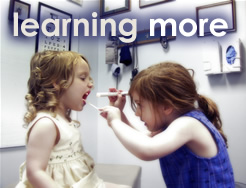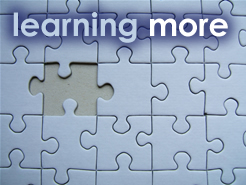
This page provides a comprehensive introduction to creating effective staff development training and programs. This resource is perfect for those who have been given the task to identify and development training needed by their business or organization.
Explore the 5 simple steps essential to effective staff development

There are five simple steps that all successful staff development programs have in common.
By developing an understanding of these five simple steps, you will be able to deliver effective, efficient, and successful training interventions that result in development of new skills, perspectives, and abilities for the employees at your work place.
- Needs assessment
- The first step is to understand the knowledge held by your target audience, the context of their professional environment, and their and their work-related training needs. Begin in this section to learn what constitutes and how to conduct a needs assessment.
- Planning
- Establishing clear goals and outcomes, learning paths, and follow-up support for your participants will assist you in fulfilling the training needs of your target audience. Read more about planning to find out what factors should be considered for a successful training initiative.
- Budgeting
- After you know what your target audience needs, you must determine what support, tools, and environment are required to implement your training intervention. Begin in this section to learn about what is involved with drafting a budget.
- Activities
- Our activities section provides samples of completed training modules and work in order to provide you with “food for thought” and “fresh starts” in regards to training activities.
- Evaluation
- In order to determine if your staff development session was successful, you will need strategies for measuring success, retention, and implementation of new skills acquired by participants during the training. Read our evaluation section to learn basic strategies for implementing an evaluation.
Conducting a staff development needs assessment

What is needs assessment?
Needs assessment is defined in the Family Planning Manager’s Handbook, a publication that provides information regarding how to run a family planning program (available electronically from the Manager’s Electronic Resource Center), as:
An analysis that studies the needs of a specific group (employees, clients, managers), presents the results in a written statement detailing those needs (such as training needs, needs for health services, etc.), and identifies the actions required to fulfill these needs, for the purpose of program development and implementation.
Why are needs assessments important?
Needs assessments enable us to ground justification for development of a training program within the real world needs of our associates or employees. Imagine the reaction of business, organizational, or institutional stakeholders if an unnecessary and potentially expensive training program was developed that did not fulfill the needs of staff. Needs assessments save money, time, and increase the potential for value in the outcomes training efforts.
Sample needs assessment document
This document demonstrates strategies for conducting a needs assessment to:
- Identify areas of need
- Needs assessment instruments
- Strategies for implementation of needs assessment
Literature review: Needs assessment
Citation
Nguyen, F. (2005). EPSS needs assessment: Oops, I forgot how to do that! Performance Improvement, 44, 33-48.
Summary of article
The Nguyen article describes an assessment conducted regarding an Electronic Performance Support System (EPSS). An EPSS was not described in detail; though, an EPSS appears to be an online help/training tool that can be utilized in conjunction with electronic diagnostic equipment used for performing maintenance on sophisticated mechanical equipment (e.g. jet engines).
The assessment was implemented using a two-part survey administered to 122 employees who were “identified as high-volume end users of online web-based training content”. The assessment measured the perceived value of different training scenarios and features of the training software.
Employees ranked training scenarios that were related to their specific job roles, context sensitive help systems, and Web sites with schematics and diagrams of equipment. The employees indicated that they would prefer a system that featured the ability to bookmark and/or print content. The use of a search engine to locate content, ability to e-mail content, and to rate information was rated very low.
The author concluded, “These results indicate that a performance support system that can intelligently provide content for specific job roles would be an invaluable performance intervention.”
Implications of staff development by author
From this article, in our exploration of staff development issues, we can conclude that developing training materials that provide contextual relevance to participants job roles will likely yield sustainable results and retention of material.
If we were to develop a new delivery mechanism for online staff development, it would be ideal to assess the features that our audience would prefer. In the case of Nguyen’s study, a search engine was not a desirable feature. Eliminating this feature, or other features specified by our target audience, will save significant development time – which can be allocated to other works that will yield a better return on our investment.
My reaction
I would have like to know a little more about the electronic training system Nguyen and his team developed. I think I would have been able to make better connections regarding their asessment tool with this extra information.
As far as content and practices go, I think that doing multiple assessments that include perspectives and desires of the target audience during the formative phases of development of the new tool would be desirable. In some cases, I wonder if the target audience would always be able to provide a sufficient assessment of the tool/method(i.e. if they aren’t familiar with the material, how can we be sure that their perceptions of the value/method are accurate – when they are not really familiar with the topic or new procedure?).
Learn more about needs assessment

Online resources
American Evaluation Association Topic Interest Group in Needs Assessment
Visit this site to find a list of useful publications, articles, presentations, and recent work done regarding needs assessment in both professional and educational evaluation settings.
About.com’s Training Needs Assessment
About.com has gained a reputation for providing easy-to-comprehend articles and guides on a variety of topics. This particular collection provides an introduction to needs assessment, tools, methods, and analysis.
National Oceanic and Atmospheric Administration Needs Assessment online learning module
This online learning module has been designed to enable participants to “develop assessment instruments such as surveys and questionnaires, understand where needs assessments fit in the project development process, and the basic steps in
Great books about needs assessments
A practical guide to needs assessment
by Kavita Gupta, Catherine M. Sleezer, and Darlene F. Russ-Eft
Training Needs Assesment: Methods, Tools, and Techniques
by Jean Barbazette
Planning staff development

What is planning?
The Bureau of Justice Assistance’s Center for Program Evaluation defines planning as:
The process of anticipating future occurrences and problems, exploring their probable impact, and detailing policies, goals, objectives, and strategies to solve the problems. This often includes preparing options documents, considering alternatives, and issuing final plans.
Why is planning important?
Planning provides you with a road map that will make sure that you reach your destination, don’t get lost along the way, or spend time pursuing non-valuable tangents. A well developed plan should be able to answer:
- What are we doing?
- What will be the result?
- Why are we doing this?
- Who will be involved?
- How long will it take?
- What will be needed?
- How will we know when we have succeeded?
- What comes next?
Sample planning document
The purpose of this project is to evaluate professional development programs currently in use at Western Michigan University. The results may indicate directions for development of new programs and strategies for improving the quality and effectiveness of professional development programs.
Literature review: What makes staff development effective?
Garet, Porter, Desimone, Birman, and Yoon (2001) conducted an evaluation of what makes professional staff development effective using a national probability sample of schools and organizations who received funds from the Eisenhower Professional Development Program (EPDP) – a program designed to fund professional development without specific preference to type or methodology of development. Their evaluation focused on staff development programs for mathematics and science teachers. All data received were from self-reports by individual teachers who received professional development funded by an EPDP grant. The study had a 72% response rate.
Garet et al. (2001) proposed their study because they felt the success of any education reform was dependent upon effective and qualified teachers. Garet et al. found that little research had been done on the effect of professional development on improved teaching and/or student outcomes. In addition, Garet et al. found that there had not been many studies which compared the effects of the different characteristics of professional development.
Garet et al. (2001) analyzed characteristics of professional development based on “structural features” and “core features”. Structural features included the “(a) form of the activity (b) duration of the activity including contact hours and span of time over which the activity took place and (c) the degree to which the activity emphasized collective participation”. Core features included “(a) the degree to which the activity has a content focus (that is, the degree to which the activity is focused on improving and deepening teachers’ content knowledge) (b) the extent to which the activity offers opportunities for active learning (e.g. meaningful analysis of teaching and learning); and (c) the degree to which the activity promotes coherence in theaters’’ professional development, by incorporating experiences that are consistent with the teachers’ goals and aligned with state standards and assessments”.
In previous literature, the most common type of professional development was found to be delivered in the form of a workshop. Garet et al. (2001) found that the majority of research criticized this method of professional development for being “ineffective in providing teachers with sufficient time, activities, and content necessary for increasing teacher’s knowledge and fostering meaningful changes in their classroom practice”. Garet et al. observed an increasing interest in “reform” professional development. Namely, activities that center on collaborative and group learning, mentoring, and coaching that occurred within the context of participants’ daily work.
Garet et al. (2001) observed that activities should provide sufficient duration for participants to discuss academic content, student reactions, and overall teaching methods. In addition, staff development may be more successful when participants are from the same school districts and/or departments – enabling them to collaborate and interact on strategies for working within their established curriculum. Garet et al. also found that it was important to consider teaching methodologies as well as how students learn content. Effective professional development was also found to involve active learning (e.g. observing how peers teach, observing an expert teacher, receiving mentoring or feedback on their own teaching).
The results of Garet et al.’s (2001) evaluation indicated that the amount of time spent and the span between activities strongly influenced the effectiveness of the professional development effort. Activities with strong content focus, coherence, and active learning all were found to produce increased knowledge and skill development. Garet et al. concluded that “sustained and intensive professional development is more likely to have an impact, as reported by the teachers, than shorter professional development”. Overall, reform and traditional professional development programs were found to be identical in quality of outcomes if each included sufficiently long duration of activities. Garet et al. emphasized the importance of focusing on subject-matter of the professional development rather than on the delivery system. In closing, Garet et al. acknowledged that long term professional development programs are more expensive to implement and maintain. However, the overall impact for each individual teacher and their students is greater. Hence, it would be ideal to “focus resources on fewer teachers, or to invest sufficient resources so that more teachers can benefit from high-quality professional development.”
Reference
Garet, M.S., Porter, A.C., Desimone, L., Birman, B.F. & Yoon K.S. (2001). What makes professional development effective? Results from a national sample of teachers. Retrieved from https://journals.sagepub.com/doi/10.3102/00028312038004915 on September 7, 2007.
Literature review: Adult learning
Citation
Yi, J. (2005). Effective ways to foster learning. Performance Improvement. Performance Improvement, 44, 34-38.
Summary of the article
Jialin Yi provides a comprehensive overview of three methods for fostering learning in adults: problem-based learning, cooperative learning, and situated learning. Yi grounds the overview of each method in established theory and research. As a whole, Yi perceives value in the three models because of a strong identification with a constructivist approach to instruction – “to enhance learning, constructivism encourages social negotiation, reflective awareness, learning occurring in real world contexts and problems, and the presentation of multiple perspectives to challenge the learners thinking.”
The table included below provides a comparison of the three different learning models as presented by Yi.
| Problem-based learning | Cooperative learning | Situated learning | |
| Outcomes sought | Enhancement of skills: Analytical Problem-diagnosing Problem-solving Critical thinking | Enhancement of skills: Cooperative Communication Interpersonal | Development of technical skills related to the field the adult works in |
| Activities involved | Learners: Explore a real problem, develop a hypothesis for solving the problem Reflect and determine what skills they have and what skills they lack for solving the problemIndependently study to obtain necessary knowledge Collaborate with team to share new knowledge and resources to solve the problem Reflect and discuss how they learned how to solve the problem | Learners: Presented with a scenario and review goals presented by instructorSmall study groups are formed Each given specific sub-topic to work on within the group. The instructor provides specific rules for group activity Participate in individual study. Upon completion individuals participate in group discussion Keep instructor up-to-date on what is happening in the group. Instructor provides ongoing support Participate in topical instruction facilitated by the instructor Reflect upon the process and activities. | Learners: Are given a scenario that relates to a real work experience or task Select a role they want to take on within the scenarioRoll play within the context of the scenario. Learners also discuss activities with entire group New knowledge is gained by doing/acting within the scenario Participate in group discussion upon completion of the entire activity Individually reflect on process, new knowledge gained, and how problems were solved. |
| Evaluation applied | Learners evaluate selves and peers on how they identified the skills they needed and obtained the required knowledge | Learners evaluate each other throughout the process. A final evaluation of the team and outcomes is also done. | Learners are evaluated on their participation in the role playing as well as through a performance assessment. A reflection paper is also utilized for evaluation. |
Implications of staff development by author
Yi suggests that adults and children learn in very different ways. Methods that are effective in a traditional classroom designed for young students do not provide relevancy or context needed for adult learners. According to Yi, “it is important to distinguish the unique attributes of adult learners so as to be better able to incorporate the principles of adult learning in the design of instruction”. The essential message from the article is that adults will learn more effectively if provided a contextual framework that relates to their day-to-day work activities.
My reaction
In my own work, I have observed that presenting a new skill within the context of a real work environment vs. in a group workshop appears to result in more effective knowledge building and retention. For example, participants in most of the larger group workshops or seminars I led (where we emphasized teaching basic software usage/configuration skills while covering some theory/practice ) did not appear to be able to directly apply knowledge gained to building Web sites or developing an online course. Whereas one-on-one training where we worked on the participant’s real course or departmental Web site each participant appeared to retain more skills and knowledge of best practices.
I am skeptical of the effectiveness of the situated learning method as it was presented by Yi. The role playing activity feels too elementary to me. I find it hard to believe that adults would be willing and comfortable with taking on this type of activity when presented with the alternative of doing guided individual study and group work. Doing a “lets-pretend” role playing activity seems a little too juvenile and a throw-back to the school room activities that Yi indicated would not be effective for adults. I also think that problem based learning is a little too basic and trivial for most needs presented by adult learners.
Ultimately, I would favor a model where adults are able to work together to determine what “problem” needs to be solved (instead of having the instructor give them a problem to solve), access and assess available knowledge, and finally collaboratively discuss and create new knowledge and resources (perhaps in a wiki that could later be shared with peers).
Literature review: Staff Development Models
Citation
Sahin, I. & Thompson, A. (2006). Using Roger’s theory to interpret instructional computer use by COE faculty. Journal of Research on Technology in Education,39, 81-104.
Rogers, E.M. (2003). Diffusion of innovations (5th ed.). New York: Free Press.
Summary of the article
The study presents a qualitative and quantitative study of instructional computer usage within a department of education at a university in Turkey using the first instrument construction, data collection, analysis, and interpretation grounded in Roger’s Diffusion of Innovation Theory (Sahin & Thompson, 2006). The university enrolls 60,000 students and has 16 colleges. The college of education at the institution has 8,533 students. The study had a 74.5% response rate. Sahin and Thompson indicate that Roger’s theory includes five steps in an innovation-decision process: knowledge, persuasion, decision, implementation and confirmation (Rogers, 2003). According to Roger’s theory, characteristics of adopted innovations consist of: “relative advantage, compatibility, complexity, trialability and observability” (Sahin & Thompson, 2006).
The study found a strong correlation between the level of computer use and faculty expertise with technology, access and/or barriers to the technology resources, attitudes towards using technology, overall support available, and the perception of the characteristics of adopted innovations mentioned earlier. The most frequently used applications by the faculty were: Internet, word processing, and e-mail. Technology was used more at home and in the office than in the classroom – primarily because computers were not available in the classroom or poorly supported there. The findings of the study within the Turkish university were consistent with studies conducted in the United States as well as with theoretical research and studies produced by academia.
Implications of staff development by author
For a staff development model to be successful in promotion of the use of technology it is essential to: identify early adopters, to support the said early adopters, communicate overall value of the technology, and increase exposure and repetitive use of new technologies. The early majority, late adopters, and laggards will be influenced extensively by the experience had by the early adopters. Increased use of an innovation (or new technology) was found to build knowledge and experience, which in turn would yield increased usage in the classroom as well as collaboration with colleagues.
My reaction
After reading this article I feel like I need to get out and read some of Roger’s research in detail for myself. The study found nearly all of Roger’s theories and models to be applicable – which means, it could be a gold mine for those of us who are looking for ways to implement successful training and/or for methods for promoting new ideas and methods amongst our colleagues. Now, if I can only get 48 hours more out of each day…I will be able to learn everything and do all that I want!
Learn more about planning

Online resources
Design your professional development program: Where to start
This is an interactive tool designed to guide school and district level professional development planning
Fermilab Leadership Institute Intergrating Internet, Instruction and Curriculum Staff Development Home Page
This Web site presents a comprehensive approach to creation of a staff development plan including components, participant characteristics, reading resources, guiding questions, and rubrics.
Wisconsin Department of Public Instruction’s Professional Development Plan kits
This Web page provides a collection of documents, kits, and templates that demonstrate how teachers in the Wisconsin public school program are expected to create a professional development plan.
Great books about planning
From Staff Room to Classroom: A Guide for Planning and Coaching Professional Development
by Robin J. Fogarty, Brian M. Pete
Programming for Staff Development: Fanning the Flame
by Peter Burke
This book presents a series of essays written by experts and practitioners in the field regarding the topic of developing and delivering staff development that engages, encourages, and supports learners.
Budgeting for staff development

What is a budget?
The U.S. Department of the Interior’s National Park Service Budget office defines budgeting as:
The process of translating planning and programming decisions into specific projected financial plans for relatively short periods of time. Budgets are short-range segments of action programs adopted that set out planned accomplishments and estimate the resources to be applied for the budget periods in order to attain those accomplishments.
Why is budgeting important?
Once you know what your target audience needs to learn, and you have a plan for how you will deliver training and follow-up support, you will need to make sure that you have the resources and tools necessary to make the staff development initative a success. Even the grandest plans will never succeed if an appropriate budget is drafted that takes into account time, money, partnerships, and resources.
Sample budgeting document
The purpose of this document is to present a budget proposal for annual staff development expenditures for a full-time faculty member at Western Michigan University. The proposal will include options for professional development based on the anticipated needs of a faculty member employed in the Educational Technology program within the College of Education. An effort will be made to allocate available funds such that the faculty member is able to attend a minimum of one professional development seminar or event as well as acquire texts or training materials relevant to their field of study.
Learn more about budgeting

Online resources
California Department of Education’s Writing Effective Proposals
This Web site presents an excellent and valuable series of specifications providing guidance for preparation of applications and proposals for funds at the state and federal levels. By following their recommendations, your budget will be more thorough and professional.
North American Coordinating Council on Japanese Library Resources’ Proposal Writing: Grantsmanship
This Web page provides answers to common questions related to writing a proposal. Including if/how you would know what to ask for when writing a budget.
Great books about budgeting
The Principal’s Guide to School Budgeting
by Richard D. Sorenson, Lloyd M. Goldsmith
Creating a Strategic Technology Plan for Your Company: Leading CTOs and CIOs on Budgeting, Analyzing Financial Goals, and Developing a Companywide Vision
by Aspatore Books Staff
Staff development activities

What is an activity?
For the purposes of our staff development discussion, we will define an activity as:
a single task or grouping of actions that enable a participant to practice a specialized and/or new capability.
Why are activities important?
Activities enable participants to learn conceptual knowledge related to new topics and to apply the new knowledge within a safe and supportive environment. Activities can help each participant to make a personal connection with prior knowledge, tie the new ability or tool to a real-work-based application, and to transform the new knowledge in interesting ways.
Sample activity document
This document is a sample staff development activity that provides an introduction to Real Simple Syndication (RSS). The document includes:
- Profile of the activity
- Learning outcomes
- A short survey/assessment
- A brief history of RSS
- Examples of RSS based Web sites
- A discussion about how RSS can help staff to stay “up-to-date”
- An explanation of what roll participants are playing in adopting this new technology
- An assessment of learning objectives of each participant
- A presentation on how to find RSS feeds
- A presentation on how to use RSS feeds
- A hands-on session where participants create their own RSS feed
- An information evaluation to measure how the session affected participants
Learn more about activities

Online resources
Association for Supervision and Curriculum Development’s Professional Development Activities
This small Web site presents a series of short articles regarding different professional development strategies including: study groups, action research, peer coaching and review, reflection, and collaborative planning.
Illinois Association of Regional Superintendents of Schools’ Professional Development Activities by State Map
This Web site serves as an example of how to present a vast series of professional development activities across the state of Illinois. The listings may serve as food-for-thought in development of your own professional development activities.
Great books about activities
Administrator’s Staff Development Activities Kit
by Michael Koehler
Resource Management for Schools: A Handbook of Staff Development Activities
by Christop Rhodes
How to evaluate your staff development initative

What is evaluation?
The Bureau of Justice Assistance’s Center for Program Evaluation defines evaluation as:
Evaluation has several distinguishing characteristics relating to focus, methodology, and function. Evaluation (1) assesses the effectiveness of an ongoing program in achieving its objectives, (2) relies on the standards of project design to distinguish a program’s effects from those of other forces, and (3) aims at program improvement through a modification of current operations.
Why is evaluation important?
Evaluations enable us to determine if the intended learning goals, objectives, and outcomes of a training initiative were met. In addition an evaluation allows us to discover if the needs and desires of participants were fulfilled. Finally, through an evaluation we can measure of participation in a training program resulted in meaningful and enduring growth, change, or development.
An evaluation can show you what went well, what didn’t, and where opportunities for improvement are.
Sample evaluation document
The purpose of this document is to provide an overview of staff development assessment in practice at Western Michigan University, to provide a sample of evaluation tools being utilized, one customized evaluation instrument for assessment of a one or more day event, and one evaluation instrument for provision of a comprehensive review of staff development at an institution.
Literature review: Program evaluation
Citation
Wenghofer, E.F., Way, D., Shaw Moxam, R. Wu, H.; Faulkner, D., Klass, D.J. (2006). Effectiveness of an enhanced peer assessment program: Introducing education into regulatory assessment. Journal of Continuing Education in the Health Professions, 26,3, 199-208.
Summary of the article
The article provides detail regarding an evaluation of an enhanced peer assessment (EPA) process utilized in Canada to identify practicing physicians who may require additional professional development in order to meet established standards. The goal of the study was to determine if EPA was perceived by physicians to be valuable and if participation in the process influenced physicians to modify their existing practices.
Participants
The study included 40 participants randomly selected from a group of physicians who met the selection criteria of being younger than 70 years of age, were practicing medicine for more than five years, and practiced as a general or family doctor, obstetrics-gynecological, or general surgeon (Wenghofer, Way, Shaw Moxam, Wu, Faulkner & Klass, 2006). Nine peer assessors who were considered to be experienced in the medical fields of the study participants received two days of training regarding EPA guidelines as well as methods for utilization of continuing education tools in paper, electronic, and Web formats (Wenghofer et al., 2006).
Process
Prior to the peer assessment each participants was asked to complete a self-reflection exercise and to identify personal learning objectives. Next, the assessors contacted participants and discussed the learning objectives that were set and how the objectives related to the physician’s practice. The assessors then reviewed 30 randomly selected patient records and conducted an interview with the participant to clarify any questions regarding details found in the patient records. The findings of the assessor are reviewed by a Quality Assurance Committee who is responsible for determining if additional action is necessary. During the process the assessors’ goal is to establish a professional development plan with the participant in addition to assessing if each participant meets established standards of professional practices. Upon completion of the EPA process the participants complete a post-assessment questionnaire evaluating the value of the process as a whole.
Conclusions
Most of the participants reported feeling apprehension about being assessed. Participants also reported feeling comfortable about the process after meeting and speaking with their assessor. The immediate feedback and quality of information received from the assessor during the process was found to be valuable by study participants. Most of the participants indicated that they made changes in their day-to-day practices based on their participation in the process.
Implications of staff development by author
The authors of the study indicated that their findings of a significant connection between peer based professional development and changes in professional practice were consistent with other studies that had been conducted in the past. The authors also indicated that further study was needed to measure the extent and endurance of changes implemented by participants.
My reaction
After reading the study, it is the impression of this author that establishing credibility of a peer or mentor is essential to the success of any peer based relationship. The efforts made by the authors of the study to select recognized experts to serve as assessors, train and prepare each of the nine assessors, and establish a mentor based relationship prior to formal evaluation of patient records appears to have significantly contributed to the acceptance of assessors by study participants and promotion of a credible partnership and dialog.
In order to plan and establish a similar peer-based professional development program it would be beneficial to:
- Select professionals who are recognized in their field
- Provide sufficient support and scaffolding to the peers/mentors
- Encourage and facilitate a positive relationship prior to any assessment
- Establish clear and shared learning objectives prior to any assessment activity
Literature review: Staff development follow-up and support
Citation
Lane, K.L., Barton-Arwood, S.M., Spencer, J.L., & Kalberg, J.R. (2007). Teaching elementary school educators to design, implement, and evaluate functional assessment based interventions: Successes and challenges. Preventing School Failure, 51,4, 35-46.
Summary of the article
In this article, Lane, Barton-Arwood, Spencer, and Kalberg present their findings of a privately funded grant project designed to provide teams of school staff with training in functional assessment procedures – enabling the team members to functionally identify, define, and adapt undesirable behavior in special education students (Lane, Barton-Arwood, Spencer, & Kalberg, 2007). A secondary goal of the study was to determine if “participation in intensive training was sufficient to develop knowledge and skills in the functional assessment process” (Lane et al., 2007).
Four schools participated in the study and sent teams comprised of a principal or designee, special educator, general educator and a fourth member of the teams choosing (Lane et al., 2007). Participants attended training sessions over seven months and received a total of 18 hours of instruction and between 10 and 12 hours of on-site support (Lane et al., 2007). Training consisted of three six-hour training sessions and bimonthly on-sight follow-up for one hour (Lane et al., 2007). Teams each identified one student attending their school, obtained parental agreement for participation, and worked with project facilitators to observe and log behavior in order to draft an intervention plan to be implemented on-site during the school day (Lane et al., 2007).
Two sample cases of student diagnosed with ADHD were presented. Student behavior and desired behaviors were described and defined. The implementation and measurement of change and effect were logged. In both cases the functional assessment based interventions had a significant effect resulting in a reduction of the undesirable behavior in each student.
Implications of staff development by author
The authors noted that one of the biggest challenges of the study was preparation of the school-based teams (Lane et al., 2007). Lane, Mahdavi, & Borthwick-Duffy; Lane, Pierson, Robertson, & Little; Stichter, Shellady, Sealander, & Eigenberger’s works (as cited in Lane et al., 2007) indicate that in order to sustain knowledge acquisition and application it is necessary to have participants apply their new knowledge within the context of their work environment while receiving ongoing support and assistance. With this in mind, Lane et al. trained the teaching teams how to use multiple data collection methods, led the teams to collect real data in order to verify accurate acquisition, and finally made sure that the teams were able to draft realistic plans for intervention. Because an intervention that was not implemented as designed would be unable to collect valid data the teaching teams were also trained on how to “assess the social validity of their plans” and were introduced to methods of collecting and reviewing data to confirm that their implementations were running as planned (Lane et al., 2007).
My reaction
The lack of value in one-time training sessions is a theme that has recurred throughout all of the articles I have reviewed for this course. While not mentioned in the above review, Lane et al. also touched on this issue. In designing their study they paid specific attention to providing follow-up training to their participants in order to insure that each member of the teaching teams were able to utilize and apply their new knowledge in a useful way.
When considering both past and future professional development options for WMU’s staff and faculty I think I can see the value of designing training with multiple sessions paired with contextual follow-up and support. For example, providing web development literacy/training sessions paired with in-office follow-up to verify that participants continue to utilize processes and approaches to web development in their day-to-day projects. Simply giving people a “how-to” and then not following-up with them appears to be the worst way to have participants retain and apply new knowledge.
Learn more about evaluation

Online resources
Research Method’s Introduction to Evaluation
The Research Methods Web site provides a scholarly overview of research methodology, terminology, and practice.
Free Management Library’s Basic Guide to Program Evaluation
Written by Carer McNamara, MBA, PhD, this guide will help you to understand in what contexts an evaluation is helpful, what is required for an evaluation, types and methods of evaluation, how to analyze information, how to report results, and who should be involved with the evaluation.
American Evaluation Association
A professional evaluation association with approximately 5000 members in all 50 U.S. states and over 60 foreign countries. The AEA publishes three professional journals, provides training, and publishes a vast collection of evaluation related resources.
Great books about evaluation
Evaluation Methodology Basics: The Nuts and Bolts of Sound Evaluation
by E. Jane Davison
Effective staff develompent: An evaluation manual
by Rudi Schollaert
Who created staff development solutions?
The Staff Development Solutions project was created by Michael VanPutten as part of his participation in the Western Michigan University graduate course titled “EDT 6480 – Designing Staff Development for Educational Technology.” It was originally created as a stand alone website and was developed using Dreamweaver, Fireworks, a CSS editor, fonts, and stock art.
Philosophy of the design
In general, resource sites often are huge repositories of links. There are not strong visuals that support the message, and there is not usually a very good explanation of what the overall value of each resource is.
Purpose
The site was designed to provide an introduction to five common phases that a developer would go through when creating new professional development or training program.
Visuals
Stock art was carefully selected to supported the overall message and theme of each section. Some of the graphics are quite large in size. A decision was made to go for large and engaging visuals that would perform well on a high resolution monitor and with a broadband connection. I feel that these images nicely complement the learning objectives and goals of the site and fit well with the content.
Content/phases
The individual phases each begin with a definition of the area (i.e. needs assessment, planning, budgeting, activities, evaluation). These definitions enable the Web site visitor to familiarize themselves with the concepts associated with the term. Next, an explanation of why the step is important is presented — the thinking behind this is that if the visitor doesn’t have a clear value or purpose for doing the step, then they will likely skip it. The remainder of the section provides a sample of a completed work or an examination of published literature on the topic. These pieces of content expose the visitor to a broader range of strategies associated with the phase/step.
The resources side bar
On the right hand side of each page there was a resource bar which presented a very short and focused list of Web sites related to the topic. The Web sites linked were selected because they featured content that addressed the questions that a new or intermediate staff developer would have. A detailed explanation is provided explaining why the developer thought the resource would be of value.
Two books on each topic were also selected, to provide a learning path (i.e. learn the concept, understand value, familiarize self with examples, explore other Web resources, select a specialized text to learn more.).
About Michael VanPutten

When this research project was created, Michael worked at Western Michigan University as the Web Developer for Enrollment Management. He had ten years of experience working with web and multimedia technology, led training sessions for faculty, staff, and students on topics including online course development, photoshop, flash, and dreamweaver. Michael was completing a masters degree in Educational Technology at WMU (and this project was part of that effort). He also served as President for the campus Webmasters’ User Group.
